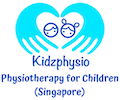Intoeing Gait / Pigeon toed Walking
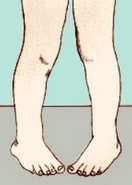
In-toeing means that when the child walks or runs, the feet turn inwards instead of pointing straight ahead. Intoeing is caused by poor rotational alignment of the thighs, knees and/or feet. This can be due to bone growth, or poor strength, flexibility and coordination of the leg and foot muscles. Some children who walk with an in-toeing pattern, may present with symptoms such as frequent trips / falls, clumsiness during physical activities, and pain.
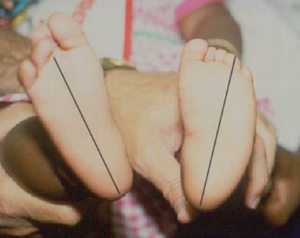
MTA of L forefoot
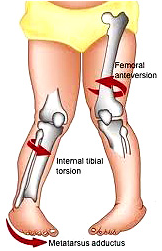
Turning in of thigh and shin bones
In-toeing may present as:
- turning in of the forefoot (metatarsus adductus = MTA),
- turning in of the shin bone (internal tibial torsion) and/or
- turning in of the thigh bone (femoral anteversion). Excessive hip internal rotation is at 80-90deg, with limited hip external rotation.
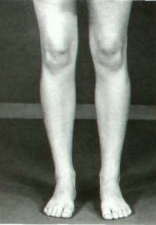
Good leg alignment
Good leg alignment in standing is when both knees face forwards and both feet face front or turned slightly outwards.
Does in-toeing improve over time?
In-toeing may be the result of the normal pattern in growth and development. It is a common finding in babies, usually caused by metatarsus adductus. The degree of flexibility of the foot will determine if treatment is required. If the foot is able to actively correct itself, then no treatment is required. If the foot does not actively correct itself, stretching is required. If the foot is rigid, bracing or casting the foot may need to be done.
Internal tibial torsion is the most common cause of in-toeing in children less than 3 years old, usually caused by the posture in the womb, but becomes obvious only when the child starts walking. This in-toeing usually resolves by 3 years old.
Excessive femoral anteversion (>60°) is the most common cause of in-toeing in children older than 3 years old. It is associated with W-sitting. While it may seem that your child’s in-toeing is improving as her/she grows older, many children still tend to have their hips rotated inwards, and compensate by twisting the lower leg outwards at the knee joints.
Can anything be done to improve the degree of in-toeing?
To improve the degree of in-toeing when standing or walking, an effective exercise program should include stretching for tight hip muscles, strengthening for the weak hip muscles, and exercises to improve balance and coordination. This will also improve your child's gross motor skills such as running and jumping. Even if surgery is being considered for severe cases, improving your child's strength, flexibility and function before surgery will improve the outcome.
Please feel free to reach out to us if you have any concerns regarding your child's leg and feet alignment or if your child’s in-toeing is associated with poor balance/coordination or delayed gross motor skills.
Let's get in touch
